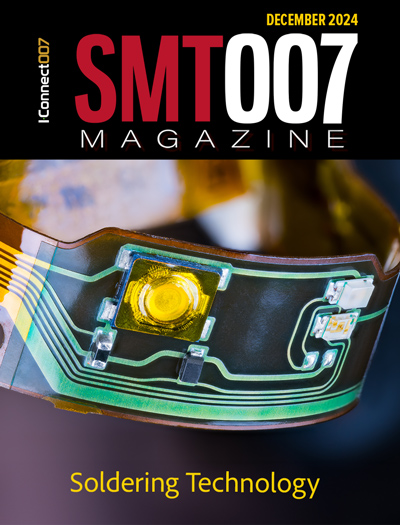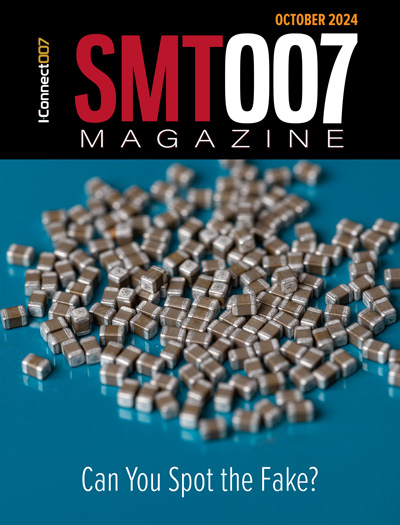-

- News
- Books
Featured Books
- smt007 Magazine
Latest Issues
Current Issue
Soldering Technologies
Soldering is the heartbeat of assembly, and new developments are taking place to match the rest of the innovation in electronics. There are tried-and-true technologies for soldering. But new challenges in packaging, materials, and sustainability may be putting this key step in flux.

The Rise of Data
Analytics is a given in this industry, but the threshold is changing. If you think you're too small to invest in analytics, you may need to reconsider. So how do you do analytics better? What are the new tools, and how do you get started?

Counterfeit Concerns
The distribution of counterfeit parts has become much more sophisticated in the past decade, and there's no reason to believe that trend is going to be stopping any time soon. What might crop up in the near future?
- Articles
- Columns
Search Console
- Links
- Media kit
||| MENU - smt007 Magazine
Process Yield Statistics and Distributions
November 25, 2024 | Dr. Pat Valentine, UyemuraEstimated reading time: 1 minute
The costs of poor quality include all expenses incurred for not making or providing a perfect product the first time, including scrap, rework, re-purchasing raw materials, labor, and inventory1. Companies operating at a three-sigma quality level can spend about 25% of their annual sales remediating poor quality costs2. Other estimates put the costs of poor quality in the range of 25–40%3. Poor quality can destroy a company.
Unexpected product failures significantly increase sales, general, and administrative (SG&A) costs and lead to increases in inventories and fixed assets required to support operations. These indirect costs erode profitability more than those directly attributable to warranty claims processes. Product recalls negatively impact businesses financially and result in adverse publicity. Customers expect printed circuit boards to meet their specifications.
An internal Motorola study found that units reworked in production often encountered problems during early customer use, even though the defects identified were corrected during production. Rework can frequently stress a unit non-standardly and predispose a product to early failure4. Denson found a similar occurrence in semiconductor manufacturing, where the reliability of computer chips was statistically correlated with the die yield5. These studies suggest that circumstances in detecting and reworking defects in some units may produce undetected damage on other units. When delivered to customers, these weaknesses often contribute to early failures.
Defects are any items that exhibit a departure from specifications. A defect does not necessarily mean that the product cannot be used; it only indicates that the product result is not as intended. In essence, defects refer to quality characteristics. Generally, the count of defects is assumed to follow a Poisson distribution.
Defectives are units that are considered completely unacceptable for use. Each unit is deemed defective or not—there are only two choices. In essence, a defective unit refers to the overall product. Generally, the count of defective units is assumed to follow a binomial distribution.
To read this entire article, which appeared in the November 2024 issue of PCB007 Magazine, click here.
Suggested Items
IDC: China Becomes the Largest Wrist-Worn Device Market, Leading Global Growth
12/26/2024 | IDCAccording to the latest Worldwide Wearables Quarterly Tracker released by International Data Corporation (IDC), the global wrist-worn device market shipped 139.0 million units in the first three quarters of 2024, a year-over-year decline of 1.0%, mainly due to the homogenization of competition and market saturation in India and the United States.
Murata to Acquire Sensoride Corporation
12/25/2024 | MurataMurata Manufacturing Co., Ltd. announces that Murata Electronics North America, Inc., a subsidiary of Murata, has entered into an agreement to acquire Sensoride Corporation (hereinafter referred to as 'Sensoride') on December 20, 2024, U.S. time.
Biden-Harris Administration Announces CHIPS Incentives Award with Texas Instruments to Expand U.S. Capacity of Current-Generation and Mature-Node Chips
12/23/2024 | U.S. Department of CommerceThe Biden-Harris Administration announced that the U.S. Department of Commerce awarded Texas Instruments (TI) up to $1.61 billion in direct funding under the CHIPS Incentives Program’s Funding Opportunity for Commercial Fabrication Facilities.
Kitron Signs Contract for Marine IoT Technology
12/23/2024 | KitronKitron has entered into a manufacturing contract with a leading technology company focusing on innovative IoT solutions.
High-Generation Panel Production Expected to Drive OLED Notebook Penetration Rate Past 5% by 2027
12/20/2024 | TrendForceTrendForce's latest OLED Technology and Market Development Report reveals that the penetration rate of OLED displays in notebooks is set to increase to 3% in 2024, driven by large-scale procurement from Chinese laptop brands. While growth in 2025 is expected to be moderate, the anticipated introduction of OLED displays in Apple’s MacBook lineup will mark a significant turning point.


